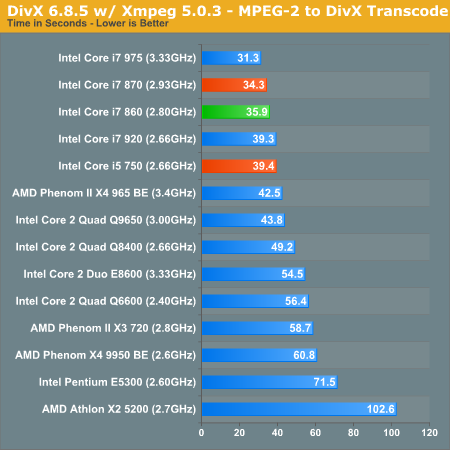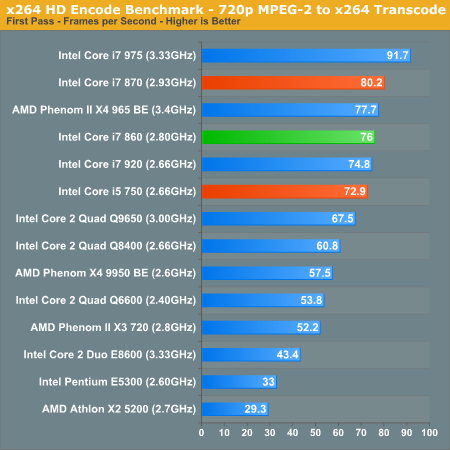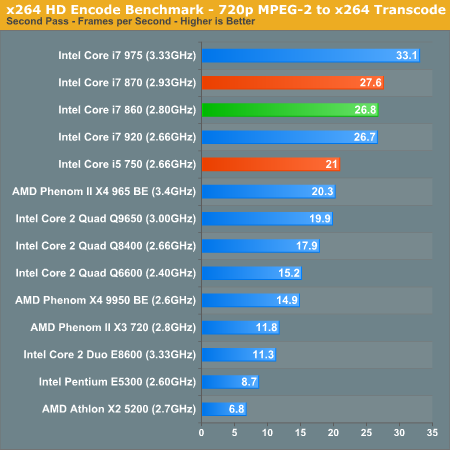DivX 8.5.3 with Xmpeg 5.0.3
Our DivX test is the same DivX / XMpeg 5.03 test we've run for the past few years now, the 1080p source file is encoded using the unconstrained DivX profile, quality/performance is set balanced at 5 and enhanced multithreading is enabled:

Lynnfield inches towards the crown with the 860; it's closer to the 870 than the Core i5 750, and that's to be expected. The biggest gains here are due to Hyper Threading, the clock speed is just icing on the cake.
x264 HD Video Encoding Performance
Graysky's x264 HD test uses the publicly available x264 codec (open source implementation of H.264) to encode a 4Mbps 720p MPEG-2 source. The focus here is on quality rather than speed, thus the benchmark uses a 2-pass encode and reports the average frame rate in each pass.

The Core i7 860 continues to do better than the i7 920, even if by only a small margin. As expected, it's closer to the 870 than it is to the i5 750 thanks to Hyper Threading.

Windows Media Encoder 9 x64 Advanced Profile
In order to be codec agnostic we've got a Windows Media Encoder benchmark looking at the same sort of thing we've been doing in the DivX and x264 tests, but using WME instead.

The race is close here, there's only a 2 second difference between the Core i7 870 and the Core i5 750. The 860 lands closer to the 750 this time.










121 Comments
View All Comments
georges1977 - Monday, September 21, 2009 - link
+1khaakon - Sunday, September 20, 2009 - link
Strongly supported. OddTSi makes a good case which I don't think is countered by GourdFM's answer. Users can be educated on this issue, methinks. It will make a better basis for making decisions regarding green computing.GourdFreeMan - Sunday, September 20, 2009 - link
I certainly understand your point of view, but most desktop users will not be concerned with task-oriented energy usage. For nearly all users you will either be in an idle situation (office work/web browsing) or a load situation (gaming)[1] for almost your entire computing session. Normal users don't sit there waiting for a task to complete and then immediately turn off the computer. Even for task oriented computing (e.g. programming, video encoding, rendering) where the user will be waiting for a task to complete before doing more useful work, the reality is that the user will be in one of those two states for the majority of their time over the year. In that sense knowing idle and load power draw is enough for most people.If you were concerned about energy efficiency of distributed computing (e.g. folding@home) your interest with task-oriented energy efficiency would be a valid concern when making purchasing decisions for infrastructure. If you are so concerned about completing the most tasks for the least amount of money on the desktop, your expenses are more likely to be dominated by salaries than energy expenditures or hardware costs. YMMV.
The cost of air conditioning can also complicate the situtation beyond naive energy usage of the computer system. If all you care about is energy usage do you pick a system that will complete the task using 1000 Wh in 4 hours or one that will complete the task using 1005 Wh in 6 hours? If it's a hot summer afternoon and you're in Death Valley you are going to expend a lot more than 5 Wh cooling the room with the former system than the latter. If it's a chilly winter's morning and you're in Siberia the first system will look a lot more attractive.
---
Footnote [1]: Actually gaming isn't so much an ideal load situation anymore since multi-core processors became common. That may change as developers become more adept at exploiting the power of multiple cores.
Eeqmcsq - Saturday, September 19, 2009 - link
> Report it in watt-seconds or kilowatt-hours or however you want, but just report it in units of energy.In other words, you want a measurement in joules for the amount of energy consumed for a task. Techreport.com has such a measurement in their CPU reviews, at least for the Cinebench task.
http://techreport.com/articles.x/17545/13">http://techreport.com/articles.x/17545/13
ProDigit - Saturday, September 19, 2009 - link
Call me crazy, but,85Watts of idle power consumption is crazy!
That's like my Core2Duo Laptop processing @ full power,while transmitting and receiving Wifi @ full speed and range, and HD fully active doing random R/W's; all while the screen's set to maximum brightness.
That's 85 Watts!
While a Corei7 does not seem to do anything at that power consumption.
It, all by itself needs all that power for staying alive! That's just plain crazy!
Anand Lal Shimpi - Saturday, September 19, 2009 - link
Keep in mind there's a much larger power supply and about 1.4 billion transistors of a GeForce GTX 280 idling in that power value as well :)Take care,
Anand
Eeqmcsq - Saturday, September 19, 2009 - link
I asked a similar question in one of the other articles, so pardon me if this sounds repetitive.According to the Turbo charts, the slowest Turbo speed is higher than the stock speed. Why is that? For example, why not just make the 750 a stock GHz of 2.8 GHz instead of 2.66GHz?
has407 - Saturday, September 19, 2009 - link
> According to the Turbo charts, the slowest Turbo speed is higher than the stock speed. Why is that? For example, why not just make the 750 a stock GHz of 2.8 GHz instead of 2.66GHz?To minimize power consumption when the core is active (C0 or C1 states) but under less than full load. (There are also other ways to manage it via, e.g., P-states, S-states, etc. but that's another subject.)
Requisite bad car analogy :) You want the lowest idle RPM that is smooth and responsive; anything more wastes resources and energy.
imsabbel - Sunday, September 20, 2009 - link
Sorry, but it seems nobody is "getting" it.I have a I860 right here.
I checked with CPU-Z.
Even if i run indigorenderer with 8 threads for an hour, it runs with x22.
So either i am the victim of a lucky mixup at intels chip packaging plant and got an 870, or something lese is wrong... (or right. As its runing perfectly fine)
strikeback03 - Monday, September 21, 2009 - link
Crank up the temperature in the case though, and it might drop back to x21.They mentioned previously with the i7 920 that more often than not runs at 2.8GHz